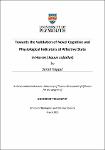Towards the Validation of Novel Cognitive and Physiological Indicators of Affective State in Horses (Equus caballus)
| dc.contributor.supervisor | Collins, Sarah | |
| dc.contributor.author | Kappel, Sarah | |
| dc.contributor.other | School of Biological and Marine Science | en_US |
| dc.date.accessioned | 2023-03-30T11:38:56Z | |
| dc.date.issued | 2023 | |
| dc.identifier | 10627596 | en_US |
| dc.identifier.uri | https://pearl.plymouth.ac.uk/handle/10026.1/20644 | |
| dc.description.abstract |
Assessing animal emotions reliably is crucial for making accurate decisions about animal welfare, but subjective affective (emotional) states are inaccessible for direct measurement. We know that negative affect modulates attention in humans and some animals. The overarching aim of this thesis is to investigate if the preferential attention allocation towards certain information (i.e. attention bias, AB) could be a potential proxy measure of affective valence in horses. First, I provide an overview of the theoretical background to attention and AB by reviewing the literature on AB in humans and animals (Chapter 2). I examine which methodological aspects need consideration when translating AB tests to animals, before describing my general methods in Chapter 3 and presenting the development of a visual attention bias test in horses using on-screen images of conspecific faces in Chapter 4. For a more informed interpretation of horses’ response in the AB test, I further investigated horses’ image recognition ability in Chapter 5. As well as cognitive measures, I explored changes in heart rate variability (HRV) and surface temperature via infrared thermography (IRT) as additional measures of affective valence in Chapter 6. Reviewing the literature, I conclude that AB is a promising novel proxy of affect, but its assessment requires further refinement for reliable application in animals. Testing horses’ attention to conspecific faces showing differently valenced facial expressions indicated no significant evidence of AB. This is possibly because artificial stimuli might not be appropriate test stimuli, as image recognition ability might not be generalizable across individual horses. Changes in physiological parameters indicated shifts in arousal but not valence, contributing to my conclusion that measuring emotional valence from indirect parameters like AB, HRV and IRT needs more refinement, which I discuss in my final chapter (Chapter 7). | en_US |
| dc.language.iso | en | |
| dc.publisher | University of Plymouth | |
| dc.subject | Animal cognition | en_US |
| dc.subject | Animal emotion | |
| dc.subject | Attention | |
| dc.subject | Animal welfare | |
| dc.subject.classification | PhD | en_US |
| dc.title | Towards the Validation of Novel Cognitive and Physiological Indicators of Affective State in Horses (Equus caballus) | en_US |
| dc.type | Thesis | |
| plymouth.version | publishable | en_US |
| dc.identifier.doi | http://dx.doi.org/10.24382/5012 | |
| dc.identifier.doi | http://dx.doi.org/10.24382/5012 | |
| dc.rights.embargodate | 2023-09-30T11:38:56Z | |
| dc.rights.embargoperiod | 6 months | en_US |
| dc.type.qualification | Doctorate | en_US |
| rioxxterms.version | NA | |
| plymouth.orcid.id | https://orcid.org/0000-0002-8877-5462 | en_US |
Files in this item
This item appears in the following Collection(s)
-
01 Research Theses Main Collection
Research Theses Main


